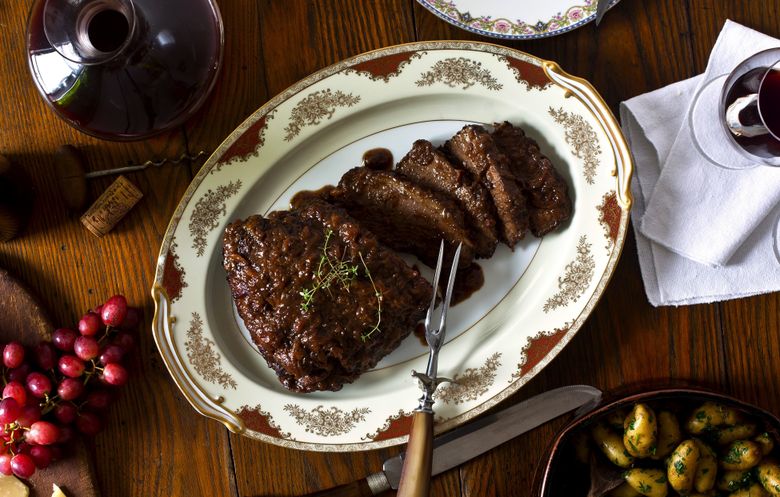I’m sorry. I’m a meat eater, and that’s just that.

A dish of braised brisket with plums, star anise and port. Brisket is as tasty as short ribs but less expensive, which is what you want when you’re cooking for a large family dinner.
For years, I thought brisket was by nature a somewhat stringy, dry and chewy cut of beef. No matter how exacting the recipe or how careful the cook, the leanness of the meat dictated the texture.
So for the Jewish holy days, I gave up and served short ribs instead. No one complained because short ribs are delicious.
Then I tasted something called the second (or the deckle) cut of brisket. For lovers of fatty meat, this is brisket nirvana. It’s juicy, it’s succulent, it falls apart under the fork with barely a nudge. It’s also as tasty as short ribs but less expensive, which is what you want when you’re cooking for a large family dinner.
You can’t find the second cut in many supermarkets, but butchers have it if you ask; they usually grind it up for hamburger. The high fat content, coupled with the cut’s inability to slice neatly, has made it undesirable to the majority of home cooks in our fat-phobic culture. So the first cut became the standard cut; it’s what you get if you just buy “brisket.”
Once you get hold of a second-cut brisket, you can cook it exactly like the first cut, with one exception. It’s really much better if made the day before so you can remove the thick white cap of fat that will rise to the surface of the liquid as it chills. Lift it off with a slotted spoon, then reheat the meat and sauce in a 300-degree oven before serving.
I like to cook the meat a few days ahead, let it cool and stick the whole pot into the refrigerator. (It will keep nicely for three to five days.) Then I remove the fat while it’s cold and leave the pot out on the counter for a couple of hours before reheating. This allows the meat to come to room temperature, making the reheating quicker and more even.
For this recipe, I added plums to the onions in the sauce for brightness, and port for sweetness. Star anise and bay leaf add depth, but you could leave them out without anyone missing them, or substitute a cinnamon stick and orange zest. And if you don’t want to use port, regular red wine spiked with a few tablespoons of honey or brown sugar is a nice substitute.
BRAISED BRISKET WITH PLUMS, STAR ANISE AND PORT
Time: 5 hours 45 minutes, plus marinating
Yield: 12 to 14 servings
1 brisket (6 to 7 pounds), preferably second cut
2 tablespoons kosher salt
1 ½ tablespoons black pepper
3 garlic cloves, thinly sliced
1 bunch lemon thyme or regular thyme
2 tablespoons extra virgin olive oil
3 white onions, thinly sliced
1 cup ruby port
½ cup dry white wine
4 whole star anise (or 2 whole cloves)
4 whole bay leaves
2 ½ pounds ripe but firm plums, halved and pitted
Thyme leaves, for garnish (optional)
1. Season brisket all over with salt and pepper. Place it in a large container and cover with garlic and half the thyme sprigs. Cover and refrigerate overnight or for at least 4 hours. Let meat stand at room temperature for 30 minutes before cooking. Wipe off garlic and thyme.
2. Heat oven to 325 degrees. Place a very large Dutch oven over high heat. Add oil. Place brisket in pot and cook, without moving, until browned, about 7 minutes per side. (Cut meat into 2 chunks and sear in batches if it doesn’t fit in a single layer.) Transfer to a plate.
3. Add onions to pot and reduce heat to medium-high. Cook onions, tossing occasionally, until golden brown around the edges and very tender, 15 to 20 minutes. Pour in port and wine and scrape up any browned bits from the bottom of the pot. Stir in star anise, bay leaves and remaining thyme. Scatter half the plums over the bottom of the pot and nestle brisket on top. Scatter remaining plums over meat. Cover pot and transfer to oven. Cook, turning every 30 minutes, until meat is completely fork tender, about 5 hours. After 4 hours, uncover the pot so some of the liquid can evaporate and sauce can thicken.
4. If you have time, let brisket cool completely in the pot, then refrigerate, covered, overnight. (This makes it easier to remove the fat from the top with a slotted spoon.) Reheat meat in a 300-degree oven for about 45 minutes before serving, if necessary. If sauce seems thin, remove meat from the pot and bring liquid to a simmer. Let cook until it’s reduced to taste. Slice meat and serve with the plum sauce, garnished with thyme leaves if you like.
